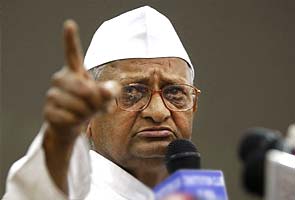 He once contemplated suicide and even wrote a two-page essay on why he wanted to end his life. Anna Hazare was not driven to such a pass by circumstances. He wanted to live no more because he was frustrated with life and wanted an answer to the purpose of human existence.
He once contemplated suicide and even wrote a two-page essay on why he wanted to end his life. Anna Hazare was not driven to such a pass by circumstances. He wanted to live no more because he was frustrated with life and wanted an answer to the purpose of human existence.The story goes that one day at the New Delhi Railway Station, he chanced upon a book on Swami Vivekananda. Drawn by Vivekananda's photograph, he is quoted as saying that he read the book and found his answer - that the motive of his life lay in service to his fellow humans.
Today, Anna Hazare is the face of India's fight against corruption. He has taken that fight to the corridors of power and challenged the government at the highest level. People, the common man and well-known personalities alike, are supporting him in the hundreds swelling to the thousands.
For Anna Hazare, it is another battle. And he has fought quite a few, Including some as a soldier for 15 years in Indian Army. He enlisted after the 1962 Indo-China war when the government exhorted young men to join the Army.
In 1978, he took voluntary retirement from the 9th Maratha Battalion and returned home to Ralegaon Siddhi, a village in Maharashtra's drought-prone Ahmadnagar. He was 39 years old.
He found farmers back home struggling for survival and their suffering would prompt him to pioneer rainwater conservation that put his little hamlet on the international map as a model village.
The villagers revere him. Thakaram Raut, a school teacher in Ralegaon Siddhi says, "Thanks to Anna's agitations, we got a school, we got electricity, we got development schemes for farmers.''
Anna Hazare's fight against corruption began here. He fought first against corruption that was blocking growth in rural India. His organization - the Bhrashtachar Virodhi Jan Andolan (People's movement against Corruption). His tool of protest - hunger strikes. And his prime target - politicians.
Maharashtra stalwarts like Sharad Pawar and Bal Thackeray have often called his style of agitation nothing short of "blackmail".
But his weapon is potent. In 1995-96, he forced the Sena-BJP government in Maharashtra to drop two corrupt Cabinet Ministers. In 2003, he forced the Congress-Nationalist Congress Party (NCP) state government to set up an investigation against four ministers. In April this year, four days of fasting brought thousands of people out in support of his crusade against corruption. They also made the government realise it could not be dismissive about Anna Hazare and his mass appeal.
His relationship with the UPA government continues to be uneasy. The truce of April was short-lived. An exercise to set up a joint committee made up of equal numbers of government representatives and civil society activists, including Anna Hazare came to naught when the two sides failed to agree and drafted two different Lok Pal Bills. The government has brought its version in Parliament and Team Anna is livid.
The Gandhian is soldiering on. From one battle to another in his war against corruption. He fought from the front to have Right to Information (RTI) implemented. He is now fighting for the implementation of the Jan Lokpal Bill, the anti-corruption bill drafted by his team of crusaders.
This year, more than 30 years after Anna Hazare started his crusade, as the 74-year-old plans a second hunger strike in Delhi against large-scale corruption at the national level. Nothing really has changed except the scale of his battle.
source: NDTV
For Further Reading,



















0 comments:
Post a Comment